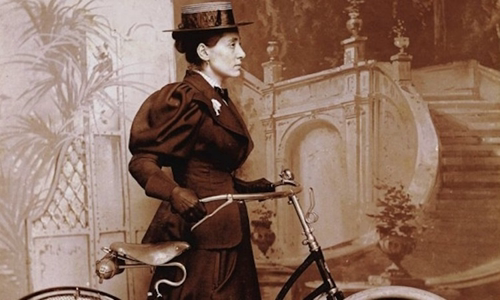Annie Londonderry rode out of her home in Boston, leaving her husband and three young children on a journey to make her a symbol of independent women.
In the decade before the beginning of the twentieth century, the world witnessed an explosion of bicycles. The so-called "safety bicycle" with two equally sized wheels driven by chains and inflatable tires was born that turned cycling from a dangerous activity, requiring skill to become a hobby. elegant and popular vehicles. Bicycles are mass produced as more men use them to go to work.

Annie on her bike Photo: totalwomenscycling.com
The birth of a bicycle is also very important for women when they first participate in this activity, enjoying the freedom it brings, bringing them out of the confines of 4 walls. . Corsets and cascading skirts even have to give way to tight pants so women can cycle more comfortably. Bicycles were really part of the early women's movement.
"Let me share with you my thoughts on cycling," women's rights activist Susan B. Anthony told New York World newspaper in an interview in 1896. "I think it helps. to liberating women more than anything else in the world, I rejoice and rejoice every time I see a woman ride a bicycle, it makes women feel free and in control. women feel like they are independent. "
In 1894, Annie Cohen Kopchovsky, a 23-year-old immigrant from Lavia, decided to leave home in Boston, leaving her husband and three children to sit on a bicycle saddle around the world. In the context of society at that time, historians rated Annie as the striking image of the trend of "free, restrained women". Although Thomas Stevens, a man from England, had traveled the world on a small wheeled bicycle before, no woman had ever tried such a feat.
Along the way, Annie signed autographs and sold souvenirs to advertise her appearance, each time she went to a new location, she sent articles to the local newspaper.
Annie delighted the crowd with stories she herself had experienced along the way. Reporters also paid great attention to her. According to Annie, she was captured by bandits in France, hunting Bengal tigers in India and across the front line of the Sino-Japanese war, where she was shot in the shoulder. Annie identifies herself as a Harvard medical student, a lawyer, an orphan, the founder of a newspaper or accounting book. With her gifted composition and self-promotion, Annie has made many people admire her.
Annie's audacious journey was completed in September 1895. She returned to Boston with a broken arm from a fall. Annie has cycled hundreds of kilometers with such injuries.
But the journey was not exactly the same as what Annie had told her. Many details have been hidden in vagueness, mainly stemming from her tendency to exaggerate.
In fact, Annie has traveled around the world on a bicycle, not by cycling. There is evidence that from Western Europe to the Middle East and from Marseilles, France, to Yokohama, Japan, she traveled mainly by ship.
Even so, the journey of thousands of miles of Annie is still an event that inspires women. When she started, she just got acquainted with the bicycle, her first bike was quite simple. She did not wear pants or pants, but remained loyal to the dress for a long time. The path she traveled was often unpaved and it took her three months to first arrive in New York and then Chicago.
Annie once considered abandoning the journey, but with a lighter new bike, she regained her motivation, cycled to New York, and then traveled by ship to Europe. There, she rode her bicycle from Paris to Marseilles. When Annie boarded the ship and departed for Alexandria, Egypt, on January 20, 1985, a crowd of thousands of people, including a team of drums, gathered to see her off.
Annie was born in Latvia in 1870 or 1871, the daughter of Levi and Beatrice Cohen. Her family moved to the United States and settled in Boston in 1875. In 1888, she married Max Kopchovsky, a street vendor, and gave birth to two daughters, one son.
One of the more noticeable aspects of the Annie story is that she chose to leave her family behind to leave on the bike. According to Annie, she made the trip to settle a bet between businessmen in Boston about whether women are physically equal to men. At every stop, Annie tells the story that she will receive $ 10,000 if she ends the journey in 15 months, in addition to the $ 5,000 she earns along the way. However, journalist Peter Zheutlin, who is also passionate about cycling, pointed out that there is no such businessman and does not exist any betting as Annie said.
After completing the trip, Annie's life returned to normal and the bike was no longer an important part of her life. Annie has written articles about cycling around the world in the New York World newspaper. On 11/11/1947, she died of a heart attack.
In her book, Zheutlin argues that Annie made the trip because of her longing for fame, excitement, and independence, which she was rejected by her usual social role at the time. She loved to tell stories, wanted stories to tell and loved introducing women on par with men.
"There is really no way to measure the impact of the adventures Annie has made on the fight for women's equality, to know how many women are inspired," wrote Zheutlin. "But Annie's journey was the perfect testament to the harmony between the women's movement and the bike craze of the time. So it was a small but new chapter in the stories of women in the period. transfer of the century ".



 LykaHabalBelisario
LykaHabalBelisario







